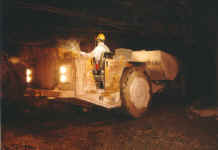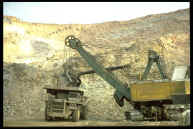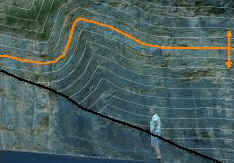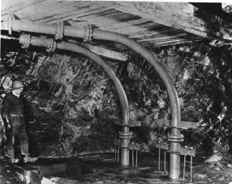| Hanging wall - the top or
upper enclosing wall of a vein. |
|
| Haulage - The horizontal
transport of ore, coal, supplies, and waste. The vertical transport of the same is called
hoisting. |

|
| Haulageway - Any underground
entry or passageway that is designed for transport of mined material, personnel, or
equipment, usually by the installation of track or belt conveyor. |

|
| Headframe - The structure
surmounting the shaft which supports the hoist rope pulley, and often the hoist itself. |

|
| Heading - A vein above a
drift. An interior level or airway driven in a mine. In longwall workings, a narrow
passage driven upward from a gangway in starting a working in order to give a loose end. |

|
| Head section - A term used in
both belt and chain conveyor work to designate that portion of the conveyor used for
discharging material. |
|
| Heaving - Applied to the
rising of the bottom after removal of the coal; a sharp rise in the floor is called a
"hogsback". |
|
| Highwall – The
unexcavated face of exposed overburden and coal in a surface mine or in a face or bank on
the uphill side of a contour mine excavation. |

|
| Highwall miner – A
highwall mining system consists of a remotely controlled continuous miner which extracts
coal and conveys it via augers, belt or chain conveyors to the outside. The cut is
typically a rectangular, horizontal cut from a highwall bench, reaching depths of several
hundred feet or deeper. |

|
| Hoist - A drum on which
hoisting rope is wound in the engine house, as the cage or skip is raised in the hoisting
shaft. |

|
| Hoisting - The vertical
transport coal or material. |
|
| Horizon - In geology, any
given definite position or interval in the stratigraphic column or the scheme of
stratigraphic classification; generally used in a relative sense. |
 |
| Hydraulic - Of or pertaining
to fluids in motion. Hydraulic cement has a composition which permits it to set quickly
under water. Hydraulic jacks lift through the force transmitted to the movable part of the
jack by a liquid. Hydraulic control refers to the mechanical control of various parts of
machines, such as coal cutters, loaders, etc., through the operation or action of
hydraulic cylinders. |
 |
| Hydrocarbon – A family of
chemical compounds containing carbon and hydrogen atoms in various combinations, found
especially in fossil fuels. |
|






